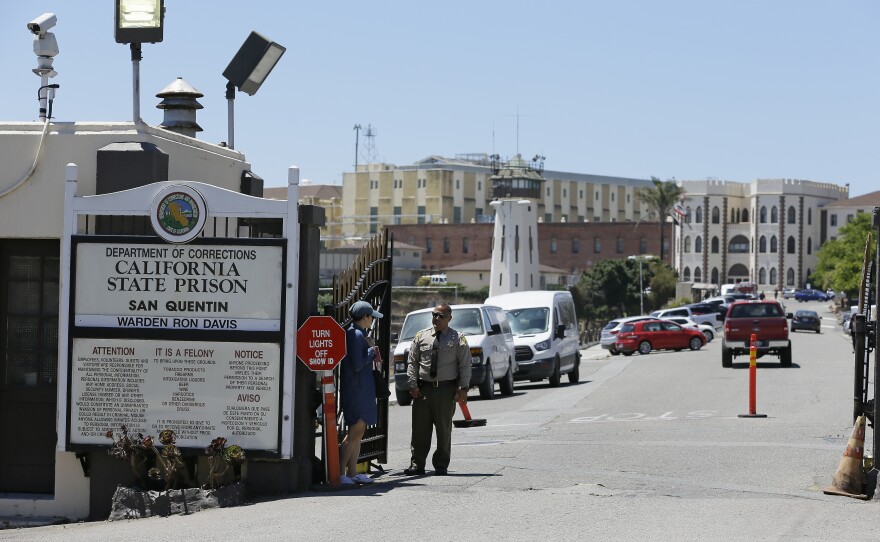From Corcoran and Avenal state prisons in the arid Central Valley to historical San Quentin on the San Francisco Bay, California prisons have emerged as raging COVID-19 hot spots, even as the state annually spends more on inmate health care than other big states spend on their entire prison systems.
The new state budget taking effect July 1 authorizes $13.1 billion for California’s 34 prisons, housing 114,000 inmates, more than three times what any other state spends. That sum includes $3.6 billion for medical and dental services and mental health care — roughly what Texas spends to run its entire 140,000-inmate prison system.
And, yet, despite the extraordinary dedication of resources, California prison officials are struggling to contain the COVID outbreaks, let alone prevent them. On March 25, there was just one confirmed COVID-19 case among California’s inmates. Three months later, more than 4,600 inmates have contracted the disease, an infection rate of about 40 per 1,000 inmates and rising — more than seven times higher than the infection rate for the state’s population as a whole. Twenty-one inmates have died. More than 730 staffers have tested positive, and two have died.
Prison systems in several other states are seeing worse outbreaks. In Ohio, at least 84 inmates have died. In Michigan prisons, 68 inmates have died. In Texas, at least 79. But given what it spends on prison health care, and its history, California might have seen the scourge coming.
Prisoner rights attorneys in California for years have waged high-profile court challenges alleging inadequate health care delivery behind bars. As a result of their efforts, federal judges in San Francisco and Sacramento oversee the state’s prison health care system. A special office, known as the California Correctional Health Care Services, has a staff of 57 to monitor the delivery of care.
“Every year, there is a major outbreak,” said San Francisco attorney Michael Bien, who for 30 years has wrangled with the state over conditions for inmates diagnosed with varying levels of mental illness. Hepatitis, HIV and other communicable diseases are common in prisons. “Prisons are like nursing homes,” Bien said. “They’re very dangerous for infectious diseases.”
In 2011, the U.S. Supreme Court concluded that California’s prisons were so crowded and the physical and mental health care so deficient that conditions amounted to cruel and unusual punishment. In response, California cut its prison population and now houses 114,000 inmates, down from a peak of 173,000 in 2006. Many health experts believe the prison system is still too crowded to keep the novel coronavirus from spreading.
The California Institution for Men in Chino, in the suburbs east of Los Angeles, was the first California lockup struck. It reports more than 890 cases involving inmates and 16 deaths. In an effort to contain the virus at the Chino prison, the California Department of Corrections and Rehabilitation (CDCR) on May 30 transferred 121 inmates considered especially vulnerable to infection 444 miles north to California’s oldest prison, San Quentin, just north of San Francisco.
Assembly member Marc Levine, a Democrat whose Marin County district includes San Quentin, said some Chino prisoners initially were housed on the upper tier of a San Quentin cellblock, called the Badger Unit. That allowed their droplets to descend on inmates below.
“Everything was preventable. Everything,” Levine said.
In a statement, CDCR spokesperson Dana Simas said inmates from Chino who had tested positive upon arrival at San Quentin “were not exposed to the general population” of the prison.
However the virus arrived, more than 830 San Quentin inmates since have tested positive. Chino inmates also were transferred to Corcoran State Prison, south of Fresno. Now, 155 Corcoran prisoners have the virus. In Lassen County, officials are blaming the transfer of prisoners from San Quentin to the California Correctional Center in Susanville for an outbreak that has infected 211 inmates in the past two weeks.
Corrections officials say they now routinely distribute cloth masks to inmates and workers throughout the prison system, providing hand sanitizer in common areas, and have increased attention to disinfecting surfaces. Prisons are screening and taking the temperatures of staffers who enter the prisons.
“We have taken unprecedented steps to address the COVID-19 pandemic in all state prisons, including the cessation of visiting, volunteers, and group programs; developing comprehensive prevention and treatment protocols,” Simas said in a statement.
California’s prisons were built to contain felons, not the coronavirus. Each of the state’s 34 prisons house 2,000 to 5,000 inmates. Many live in dorms, sleeping in double bunks and sharing showers and dining halls. Others live two to a 60- to 80-square-foot cell.
Earlier this year, to create more space, the state sped the release of 3,500 inmates who had less than six months to serve on their sentences. Starting July 1, the state once more will start speeding the release of prisoners who have six months or less left on their sentences, with caveats: They cannot have been convicted of violent or serious felonies, domestic violence or sex crimes.
They also must have plans for housing. That’s important for officials grappling with California’s other epidemic: homelessness.
It’s not clear whether COVID-related releases from state prisons have amplified the state’s homeless crisis. But El Dorado County District Attorney Vern Pierson, vice president of the California District Attorneys Association, predicts it’s a matter of time.
“We’re going to exacerbate an already bad situation,” Pierson said. “The numbers that will become homeless will be high. The supervision will be less and less. The likelihood of reoffending will likely go up.”
In Sacramento, Mayor Darrell Steinberg, co-chair of Newsom’s homelessness task force, said that since the start of the pandemic the capital city has moved 800 people from the streets into hotels, a hopeful sign.
But that gain has been more than offset because fewer people are in county jails. To limit the spread of the coronavirus in county lockups, jailers statewide have reduced the number of total inmates from 72,000 to 51,000, the California Board of State and Community Corrections reports.
In part because of those releases, homeless encampments along the Sacramento River have “grown and grown in a very significant way,” Steinberg said. Similar spikes in homelessness are occurring across the state.
Releasing people, “if they do not present a real risk,” is not the problem, Steinberg said. “The problem is releasing them without any connection with housing and the support necessary for them to be successful.”
CDCR’s response to the pandemic will come under scrutiny in a July 1 oversight hearing to be convened by state Sen. Nancy Skinner, a Berkeley Democrat who chairs the Senate Committee on Public Safety.
“What are the biggest congregate facilities in the state? Prisons,” Skinner said. “They are exactly the type of facility no one wants to be in a pandemic.”
California’s efforts to stem the outbreaks matter beyond the prison gates, several experts noted. Prison workers go home at the end of their shifts. Inmates too sick to be cared for in prison infirmaries are sent to community hospitals. Ultimately, prison health and public health are inextricably intertwined.







